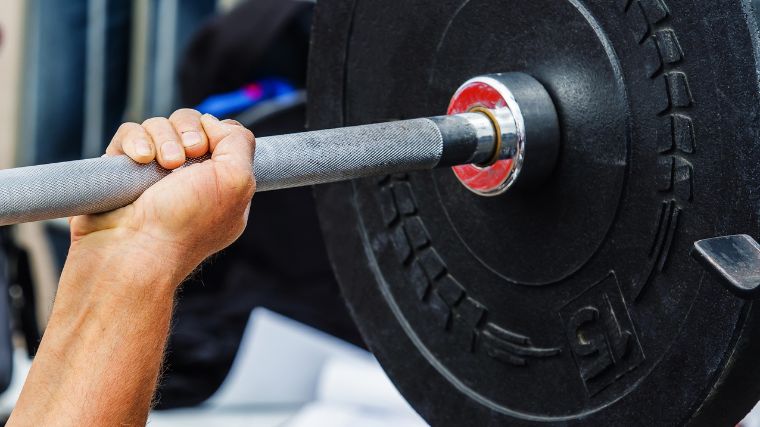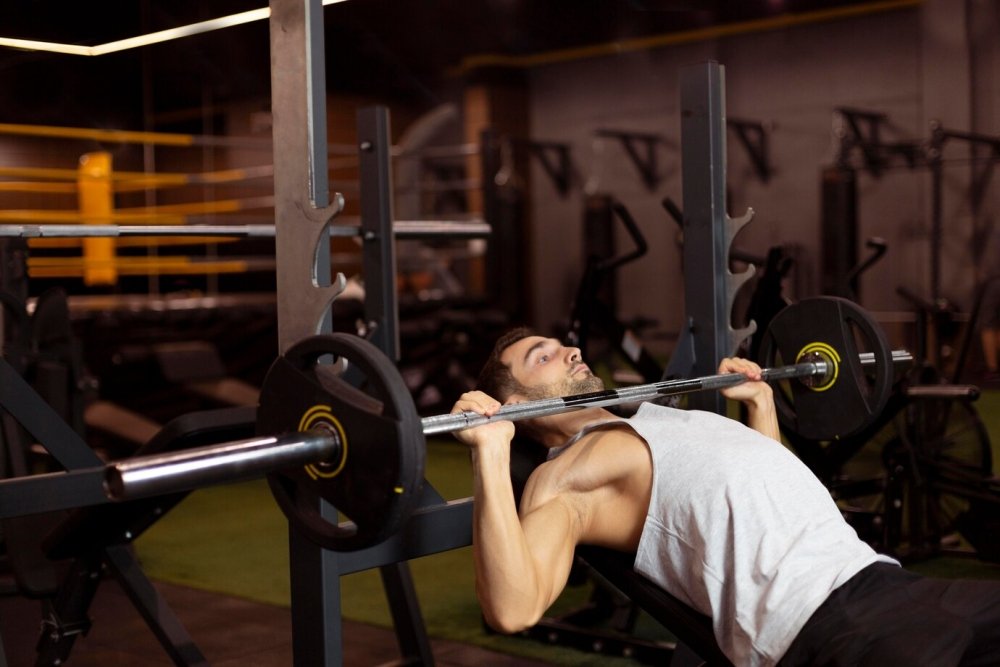Let’s spice up your workout routine with a move that’s as cool as it sounds – the Reverse Grip Bench Press.
Imagine you’re in the gym, pumping iron, and suddenly everyone’s eyes are on you because you’re doing something totally unique. Yep, that’s the Reverse Grip Bench Press for ya!
Why is it so awesome?
Well, not only does it target your chest muscles like a regular bench press, but it also gives some extra love to your triceps and shoulders.
Plus, it’s a fun twist on a classic move that’ll leave you feeling like a total boss.
Let’s get ready to turn heads with this killer exercise:
What is a Reverse Grip Bench Press?
The reverse grip bench press is a type of weightlifting exercise where you lie on a bench and hold the barbell with your palms facing towards you instead of away from you.
Then, you push the barbell upward to work out your chest, shoulders, and arms.
It's like a regular bench press, but with your hands flipped around.
How To Do A Reverse Grip Bench Press?
Here’s a step-by-step guide of how to perform the reverse grip bench press:
- Set Up: Lie flat on a bench with your back pressed against it. Make sure your feet are firmly planted on the ground.
- Grip: Grab the barbell with both hands, but instead of having your palms facing away from you like in a regular bench press, rotate your hands so your palms are facing towards you. Your hands should be slightly wider than shoulder-width apart.
- Positioning: Lift the barbell off the rack and hold it directly above your chest with your arms fully extended.
- Lower the Bar: Slowly lower the barbell towards your chest while keeping your elbows tucked in close to your body. Aim to bring the barbell down until it lightly touches your chest.
- Push Up: Push the barbell back up to the starting position by extending your arms. Focus on pushing through your palms and keeping your chest muscles engaged.
- Repeat: Complete the desired number of repetitions, making sure to maintain control over the barbell throughout the movement.
- Safety: Always use a spotter when lifting heavy weights, especially if you're new to the exercise or pushing yourself to lift heavier loads.
- Cooldown: Once you've finished your set, carefully rack the barbell back onto the rack and take a moment to stretch your chest and arms to help prevent stiffness and injury.
Muscles Worked in The Reverse Grip Bench Press
Here's a breakdown of the muscles worked during the reverse grip bench press:
Chest (Pectoralis Major)
The primary muscle group engaged in the reverse grip bench press is the chest. The movement involves pressing the weight away from the body, which activates the pectoralis major muscles, particularly the lower and middle portions.
Triceps Brachii
The reverse grip bench press places greater stress on the triceps compared to the traditional bench press. The triceps are heavily involved in extending the arms during the upward phase of the lift.
Shoulders (Deltoids)
The anterior (front) deltoid muscles of the shoulders assist in stabilizing the shoulder joint during the exercise. Due to the altered hand position, they are engaged to a greater extent.
Forearms and Grip
Holding the barbell with a reverse grip also engages the forearm muscles and grip strength to a greater degree than the traditional bench press. This can be beneficial for improving overall forearm and grip strength.
Benefits of the Reverse-Grip Bench Press
The reverse-grip bench press offers several benefits, including:
1. Enhanced Triceps Engagement
The reverse grip places greater emphasis on the triceps compared to the traditional bench press.
This can be advantageous for individuals looking to specifically target and strengthen the triceps muscles.
2. Increased Upper Chest Activation
While both the traditional and reverse grip bench presses target the chest muscles, the reverse grip variation may emphasize the upper portion of the chest to a greater extent. This can help develop a more well-rounded chest.
3. Reduced Shoulder Strain
Some individuals find that the reverse grip bench press places less strain on the shoulders compared to the traditional grip.
This can be beneficial for those with shoulder issues or discomfort during the regular bench press.
4. Improved Wrist Comfort
The reverse grip can be more comfortable for some individuals, particularly those who experience wrist discomfort or strain with the traditional bench press.
The supinated (palms facing towards you) grip may alleviate wrist issues for some lifters.
5. Increased Forearm and Grip Strength
Holding the barbell with a reverse grip engages the forearm muscles and grip strength to a greater degree than the traditional bench press.
This can lead to improvements in overall forearm and grip strength, which can be beneficial for various other exercises and daily activities.
6. Variety and Muscle Stimulation
Incorporating the reverse-grip bench press into your workout routine adds variety and can help stimulate muscle growth by targeting the muscles from a different angle.
This can prevent plateaus and keep your workouts challenging and effective.
7. Functional Strength
The reverse grip bench press can translate to improved functional strength, as it mimics movements that may be encountered in activities of daily living or sports that require pushing or pressing motions with a different hand position.
Reverse-Grip Bench Press Mistakes To Avoid
Avoiding common mistakes is crucial to safely and effectively perform the reverse-grip bench press. Here are some key mistakes to watch out for:
· Not Using a Spotter
Always have a spotter or use safety bars when performing the reverse-grip bench press, especially when lifting heavy weights.
A spotter can assist you in case you struggle to lift the weight or lose control of the barbell, reducing the risk of accidents or injury.
· Gripping Too Narrow or Wide
Find a grip width that feels comfortable and allows you to maintain proper form. Gripping the barbell too narrowly or too wide can compromise your stability and limit the effectiveness of the exercise.
· Losing Control of the Barbell
Maintain control of the barbell at all times. Avoid bouncing the barbell off your chest or using momentum to lift the weight.
Control the descent and ascent of the barbell to maximize muscle engagement and minimize the risk of injury.
· Lifting Too Heavy
Start with lighter weights to master the technique and gradually increase the weight as you become more proficient. Lifting too heavy too soon can compromise your form and increase the risk of injury.
· Overarching the Lower Back
Maintain a neutral spine throughout the exercise. Avoid arching your lower back excessively, as this can lead to strain or injury. Engage your core muscles to stabilize your spine.
· Flaring Elbows
Keep your elbows tucked close to your body throughout the movement.
Avoid letting your elbows flare out to the sides, as this can place excessive stress on the shoulder joints and increase the risk of injury.
· Neglecting Shoulder Mobility
Adequate shoulder mobility is essential for performing the reverse-grip bench press safely and effectively.
If you have limited shoulder mobility, consider incorporating mobility exercises and stretches into your warm-up routine to improve flexibility and reduce the risk of injury.
How To Improve Your Reverse Grip For Bench Press?
Here are some of the best tools to improve your reverse grip for bench presses:
Hand Gripper
The hand gripper serves as an excellent tool for enhancing your reverse grip strength, which is essential for the reverse grip bench press.
By regularly squeezing the gripper with your palms facing towards you, you specifically target the muscles required for the reverse grip bench press.
Gripzilla Tornado
Designed to fit comfortably in your hand, it offers adjustable resistance levels to match your strength level.
By focusing on squeezing the Tornado with a reverse grip, you engage and strengthen the forearm muscles crucial for maintaining a solid grip on the barbell during the bench press.
Gripzilla Dynamo
The Gripzilla Dynamo plays a vital role in enhancing your reverse grip for the bench press by targeting comprehensive forearm development.
With its adjustable resistance settings and versatile design, it allows you to customize your grip training to suit your needs.
By incorporating both clockwise and counterclockwise rotations, the Dynamo effectively engages all forearm muscles involved in the reverse grip bench press, promoting balanced strength and stability.
Over To You
So, next time you hit the gym, don’t be afraid to shake things up and try the Reverse Grip Bench Press.
Your chest, triceps, and shoulders will get a cool workout.



